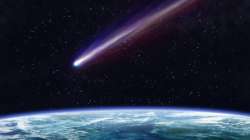Comet strike may have led to ancient global warming event, claims study
A comet strike may have triggered the rapid warming of Earth caused by an accumulation of atmospheric carbon dioxide 56 million years ago, which offers analogs to global warming today, researchers have found.

A comet strike may have triggered the rapid warming of Earth caused by an accumulation of atmospheric carbon dioxide 56 million years ago, which offers analogs to global warming today, researchers have found.
Sorting through sample of sediment from the time period, researchers from the Rensselaer Polytechnic Institute in the US discovered evidence of the strike in the form of microtektites – tiny dark glassy spheres typically formed by extraterrestrial impacts.
“The coincidence of an impact with a major climate change is nothing short of remarkable,” said Morgan Schaller, assistant professor at Rensselaer.
Schaller was searching for fossilised remains of Foraminifera, a tiny organism that produces a shell, when he first noticed a microtektite in the sediment he was examining.
Microtektites are typically dark in colour, and do not stand out on the black sorting tray researchers use to search for light-coloured fossilised remains. Once Schaller noticed the first microtektite, researchers switched to a white sorting tray.
At peak abundance, the research team found as many as three microtektites per gram of sediment examined.
Microtektites are spherical, or tear-drop shaped, and are formed by an impact powerful enough to melt and vaporise the target area, casting molten ejecta into the atmosphere.
Some microtektites from the samples contained “shocked quartz,” definitive evidence of their impact origin, and exhibited microcraters or were sintered together, evidence of the speed at which they were travelling as they solidified and hit the ground.
Atmospheric carbon dioxide increased rapidly during the Paleocene-Eocene Thermal Maximum (PETM), and an accompanying spike in global temperatures of about five to eight degrees Celsius lasted for about 150,000 years.
However, the source of the carbon dioxide had not been determined and little is known about exact sequence of events. One clue can be found in a sudden shift in the ratio of carbon isotopes (atoms containing a number of neutrons unequal to the protons in their nucleus) in certain fossils from the time period.
In particular, Foraminifera, or “forams,” produce a shell whose chemistry is representative of atmospheric and ocean carbon isotopes. The research team initially set out to examine the ratio of carbon isotopes in Foraminifera fossils over time, to more closely pinpoint events during the PETM.
The discovery of microtektites was “completely by accident” said Schaller.
Ordinarily, the team passes samples through sieves of various sizes, to isolate samples most likely to contain forams.
The tektites, which are smaller than most forams, would have been largely removed in this process. Once the team made the discovery, they obtained a sample from a fourth site – Medford – where the unit is naturally exposed at the surface.
The Medford samples also contained microtektites. The research appears in the journal Science.
(With agency input)